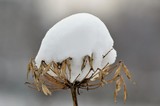13 April, 2020
- Gary Schooley
- 168 Views
- 4 Comments
Jotz and How To Make Them
Greetings group:
Yesterday I uploaded some art from a new artform titled Jotz, but the text instructions on how to make that art disappeared. For anyone who wants to make Jotz, here are the instructions:
JOTZ A jot is the smallest part of any written language. A period is a jot. This artform is based on jots, lots of 'em. Some look like totems and some look like doilies, but all are JOTZ. Do you remember those large posters that you color in with markers? They were always such a satisfying pastime. Jotz are just as satisfying, addictive even (and they don't dry out). 1. To start a basic dot totem, in MS Paint, as a bitmap*, using the largest spray tool, foreground is white on a black background. Spray a verticle strip. Do this several times where each strip is just next to the previous one. They key to a good result is in how rich or lean the original spray was. If it is too rich, the whole thing will fill (with color); too lean and almost nothing will fill. You won't really be able to tell till step 2. It can be a bit of a challenge getting the spray density just right, but it's worth it. You can then save a productive dot field and use it again and again; as long as it is dropped a few dots away from a previous Jotz, it will produce completely different results. 2. First, crop your dot field into a rectangle. Then, copy that, flip horizontally and paste down on top of the first one. Make sure Paint is set for transparent. Jotz work out best if there is one single dot overlap in the center rather than two side-by-side. If you zoom in before you paste the second image, it is easy to get it just right. By sliding the overlay image sideways, you can see various "islands" emerge within the dots. Once you get it like you like, drop it (paste it). Sometimes, a horizontal reference line below the dot field helps with alignment; sometimes veticle, too. On a complex four-way Jotz, one single red reference dot can be used; pasted in zoom mode, red dots can be aligned over each other in all four directions. 3. Now for the fun part: Once you get a mirrored dot field, start filling connected white fields with color. It is best to do all this while zoomed in some. Fill in as many of the larger fields as you want with whatever color you want. 4. Once you have filled the major fields with color, it's time to "etch" away the excess white dots ("noise"). Using one of the least used colors, usually brown, use the box tool to "brown box" your totem (note: if you used brown in your totem, use another unused color). 5, 6, 7, 8 (...) Using your fill tool, alternatly fill with white foreground and black background till most if not all noise is gone, leaving a black background. Some noise will be isolated and you must go in and clean it up by hand. 9. Fill box with brown. 10. Fill box with black (brown box is gone). Your Dot Totem is finished! * About Bitmaps Jotz were created on original MS Paint (or Paintbrush). It is unknown how newer versions of Paint, as in windows 10, will handle them. I have not messed with it much. Bitmap files are HUGE. But, bitmaps are "pure"; there are no "artifacts" like other formats. once you have finished a Jotz, before you send it anywhere, it is best to convert it to another more compact format. Once you convert out of .bmp, you can't go back; it'll never be the same because of "cooties" (artifacts), so always save an original bitmap. Advanced Jotz Once you have mastered the basics of Dot Totems, there are a number of variations and tricks you can use. Gradients: In the MS Paint color tool, set up a string of custom color variations, then use that to fill a string of shapes. You can take a simple totem and four-square it into something quite beautiful and exotic. All you do is make 1/4 of something then flip and rotate it into a full square (or circle). Once it becomes big and/or round, it becomes a "digital doilie". On a complex four-way Jotz, one single red reference dot can be used; pasted in zoom mode, red dots can be aligned over each other in all four directions. Instead of using dots from the spray tool, you can use a batch of text that has been chopped up a bunch. By using text, you have all your fonts to choose from, even the ones that are pictures rather than text characters. You can slice and dice those into interesting dot fields. You can connect groups of dots with "fill lines" to generate various "vine-like" effects. If you put a fill line down through a not very productive dot field, suddenly it looks like it has "leaves" on it. Funny note: You remember those 3-D "hidden image" things that looked like just a dot field till you looked a certain way at them? By pasting down a single verticle spray pass, side by side repeatedly, you can make a fake dot field and allow people to think there is a hidden image in there. Watch 'em go cross-eyed looking for it! hehehe WARNING: Jotz can be quite addictive. Beware. (I once boiled an entire pot of coffee down to syrup because of being engrossed in Jotz!)

